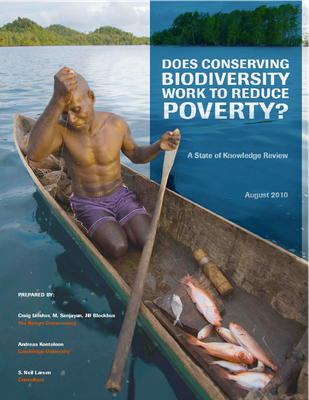Does Conserving Biodiversity Work to Reduce Poverty: A State of Knowledge Review

Author(s): Craig Leisher, M. Sanjayan, Jill Blockhus, Andreas Kontoleon, and S. Neil Larsen.
Publication Date: 2010
DOWNLOAD FILE
Key points in document
- Over 400 documents on biodiversity conservation and poverty reduction were reviewed for the assessment
- The assessment focuses on a wide range of conservation approaches, including non-timber forest products, timber, payments for environmental services, nature-based tourism, fish spillover, mangrove conservation and restoration, protected areas, agroforestry, grasslands management, and agro-biodiversity conservation.
- The assessment describes the extent to which each of these approaches have been shown to reduce poverty.
- The review aims to elucidate the importance of biomass versus biodiversity to the outcomes for the community. For example, biomass is important for forestry projects, while biodiversity is important for tourism.
- The assessment has a focus on ensuring that benefits reach the poor, and therefore strongly addresses the need for equal benefit sharing and distribution.
- All of the challenges identified in the assessment regarding reducing poverty through conservation projects ultimately lead back to a lack of benefit sharing, either in the form of elite capture, widening income disparities, ensuring the participation of poor members of the community, or discrimination against women.
Information relevant to Learning Questions:
Are enabling conditions in place to support a sustainable enterprise?
- Market demand
- Business alliances
- Technical capacity
- Infrastructure
- Benefit sharing, biodiversity linkage, policies for and enforcement of resource use, planning for external disturbance
Does the enterprise lead to benefits to stakeholders?
- Increased income for participants
- Non-cash benefits
Do the benefits lead to positive changes in attitudes and behavior?
- Behaviors regarding sustainable use of resources
Does a change in stakeholders’ behaviors lead to a reduction to threats to biodiversity (or restoration)?
- Agriculture and aquaculture
- Biological resource use
- Climate change and severe weather
Does a reduction in threats (or restoration) lead to conservation?
- Forest ecosystems
- Freshwater ecosystems
- Grassland ecosystems
- Marine ecosystems
- Species

